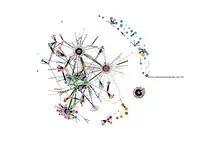The UK Web Archive is a consortium of the six UK legal deposit libraries which aims to collect all UK websites at least once each year.[1]
| UK Web Archive | |
|---|---|
 | |
| Established | 2005 |
| Reference to legal mandate | Yes, provided in law by:
|
| Other information | |
| Website | Official website |
 Libraries providing access to the archive. | |
History
In 2005, the British Library, The National Archives, Wellcome Trust, National Library of Scotland, National Library of Wales and JISC formed the UK Web Archiving Consortium, a project to archive websites.[3]
UKWAC archived selected websites by licence or permission, using PANDAS software developed by the National Library of Australia. During the project its members collected sites relevant to their interest; the Wellcome Library collected medical sites, the national libraries sites that reflect life in contemporary Wales or Scotland. The British Library worked with a broad policy of collecting sites of cultural, historical and political importance to the UK.[4]
The Consortium wound up in 2010. The Archiving and Preservation Working Group took over UKWAC's co-ordinating role web archiving in the UK. The Digital Preservation Coalition hosts the working group.[5]
Web Archiving
The archive undertakes an annual crawl of .uk and other UK geographic Top Level Domains such as .scot, .cymru or .london.

The crawl is archived in a shared infrastructure called the Digital Library System. Members of the public can nominate sites for preservation there through the UKWA website. The whole web archive is available to registered readers on library premises; and where permission has been given, or license conditions can be met, copies are also accessible through the website.[6]
The archive gathers sites in response to events, building collections - these have preserved writing and imagery recording natural disasters, election campaigns since 2005 and the UK's blogosphere for research, among more than a hundred more.[7]
SHINE

The UK Web Archive holds a collection of all the .uk websites that were archived by the Internet Archive until the end of March in 2013.[8] SHINE is a web interface which can be used to create repeatable lists of results of historical .uk pages. Trends, or occurrences of keywords in the data set on .uk pages over that time, use concordance to show keywords in context.[9]
Mementos
Memento is a name for prior versions of web pages coined by the Memento Project. The UK Web Archive Memento interface allows Mementos to be found across web archives.[10] The interface can be used to find a Memento by its date in a snapshot table, or see how often a site appears across public web archives.
Researching the archive
Research into the web as a reflection of society has helped develop access to the archive.[11] Libraries have developed guides to research skills needed to use web archives. These include using big data to see patterns or trends,[12] or writing citations for archived copies of websites.[13]
GLAM Workbench
GLAM Workbench is a project which looks at how researchers can use data preserved by galleries, libraries, archives and museums.[14] It includes a collection of Jupyter notebooks which draw on Mementos and index data.[15] The notebooks mix description and editable code to help researchers find evidence in web archives.
| Where the whole archive can be accessed, by Library | |||||
|---|---|---|---|---|---|
| 🌍 | 🌍 | 🌍 | 🌍 | 🌍 | 🌍 |
See also
References
- ↑ "UKWA Home". www.webarchive.org.uk. Retrieved 2020-10-13.
- ↑ "The Legal Deposit Libraries (Non-Print Works) Regulations 2013". legislation.gov.uk. Retrieved February 21, 2022.
- ↑ "15 Years of the UK Web Archive - The Early Years - UK Web Archive blog". blogs.bl.uk. Archived from the original on 8 March 2020. Retrieved 2020-10-13.
- ↑ "UK Web Archiving Consortium: Evaluation Report". Digital Preservation Coalition. April 2006. Archived from the original on 9 January 2017. Retrieved 17 March 2014.
- ↑ "Web Archiving & Preservation Working Group - Digital Preservation Coalition". www.dpconline.org. Archived from the original on 31 July 2020. Retrieved 2020-10-13.
- ↑ "What is the UK Web Archive?". UK Web Archive. Archived from the original on 5 December 2019. Retrieved 17 March 2014.
- ↑ "15 Years of UKWA - Looking back at our first collections - UK Web Archive blog". blogs.bl.uk. Archived from the original on 29 July 2020. Retrieved 2020-10-19.
- ↑ www.webarchive.org.uk. "JISC UK Web Domain Dataset (1996-2013)". data.webarchive.org.uk. Retrieved 2020-10-16.
- ↑ "Trend results 1996-2013 for "big data" :: SHINE". www.webarchive.org.uk. Retrieved 2020-10-13.
- ↑ "Mementos - Archived history of www.webarchive.org.uk". Mementos - Finding historical archives across the world wide web. Retrieved 2020-10-09.
- ↑ Blaney, Jonathan (19 April 2016). "More project case studies available". Big UK Domain Data for the Arts and Humanities. Archived from the original on 16 February 2017. Retrieved 2020-10-09.
- ↑ McNally, Anna. "LibGuides: Finding and Using Digital Archives during COVID-19: Web archives". libguides.westminster.ac.uk. Retrieved 2020-10-14.
- ↑ Thomas, Susan. "Oxford LibGuides: Web Archives: Home". ox.libguides.com. Retrieved 2020-10-14.
- ↑ "Welcome to the GLAM Workbench - GLAM Workbench". glam-workbench.github.io. Retrieved 2020-10-13.
- ↑ Sherratt, Tim; Jackson, Andrew (2020-06-15). "GLAM-Workbench/web-archives". Zenodo. Bibcode:2020zndo...3894079S. doi:10.5281/zenodo.3894079.
- ↑ Team, National Records of Scotland Web (2013-05-31). "NRS Web Continuity Service". National Records of Scotland. Archived from the original on 18 January 2020. Retrieved 2020-10-13.
- ↑ "Search the PRONI Web Archive". nidirect. 2015-12-09. Archived from the original on 27 Aug 2020. Retrieved 2020-10-13.
- ↑ "MirrorWeb - UK Parliament Web Archive". webarchive.parliament.uk. Retrieved 2020-10-13.
External links
- UK Web Archive home page
- The UKWA blog
- UK Government Web Archive Archived UK government websites, run by UK National Archives
- Digital Preservation Coalition - Web Archiving and Preservation Task Force